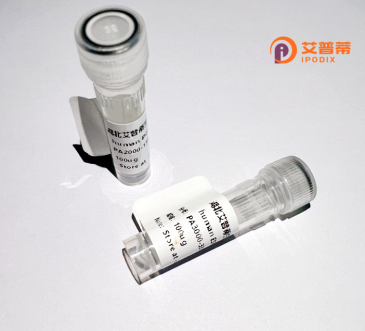
| 纯度 | >90%SDS-PAGE. |
| 种属 | Human |
| 靶点 | CXXC5 |
| Uniprot No | Q7LFL8 |
| 内毒素 | < 0.01EU/μg |
| 表达宿主 | E.coli |
| 表达区间 | 1-322aa |
| 氨基酸序列 | MSSLGGGSQD AGGSSSSSTN GSGGSGSSGP KAGAADKSAV VAAAAPASVA DDTPPPERRN KSGIISEPLN KSLRRSRPLS HYSSFGSSGG SGGGSMMGGE SADKATAAAA AASLLANGHD LAAAMAVDKS NPTSKHKSGA VASLLSKAER ATELAAEGQL TLQQFAQSTE MLKRVVQEHL PLMSEAGAGL PDMEAVAGAE ALNGQSDFPY LGAFPINPGL FIMTPAGVFL AESALHMAGL AEYPMQGELA SAISSGKKKR KRCGMCAPCR RRINCEQCSS CRNRKTGHQI CKFRKCEELK KKPSAALEKV MLPTGAAFRW FQ |
| 分子量 | 32.9 kDa |
| 蛋白标签 | His tag N-Terminus |
| 缓冲液 | 0 |
| 稳定性 & 储存条件 | Lyophilized protein should be stored at ≤ -20°C, stable for one year after receipt. Reconstituted protein solution can be stored at 2-8°C for 2-7 days. Aliquots of reconstituted samples are stable at ≤ -20°C for 3 months. |
| 复溶 | Always centrifuge tubes before opening.Do not mix by vortex or pipetting. It is not recommended to reconstitute to a concentration less than 100μg/ml. Dissolve the lyophilized protein in distilled water. Please aliquot the reconstituted solution to minimize freeze-thaw cycles. |
以下是关于重组人CXXC5蛋白的3-4条参考文献及其摘要内容的简要概括:
1. **文献名称**:*CXXC5 Suppresses Colorectal Cancer by Promoting TGFβ Signaling Through crosstalk with SMAD4*
**作者**:Xu, X. et al.
**摘要**:本研究揭示了重组人CXXC5蛋白通过增强TGFβ/SMAD信号通路抑制结直肠癌进展的机制。实验表明,重组CXXC5能与SMAD4直接结合,促进肿瘤抑制基因的表达,并抑制肿瘤细胞增殖和迁移。
2. **文献名称**:*Recombinant Human CXXC5 Modulates Wnt/β-catenin Signaling in Osteoblast Differentiation*
**作者**:Kim, J.H. et al.
**摘要**:文章报道了重组人CXXC5蛋白在成骨分化中的双重作用。通过体外实验证实,CXXC5通过与Dishevelled蛋白相互作用,抑制Wnt/β-catenin信号通路的活性,从而影响骨髓间充质干细胞的成骨分化过程。
3. **文献名称**:*CXXC5 as a DNA Methylation Reader: Role in Epigenetic Regulation of Gene Expression*
**作者**:Zhang, M. et al.
**摘要**:该研究解析了重组人CXXC5蛋白的CXXC结构域特异性识别非甲基化CpG位点的分子机制,并发现其通过招募组蛋白修饰复合物(如HDAC),调控靶基因的表观遗传沉默,尤其在造血干细胞分化中发挥作用。
4. **文献名称**:*Recombinant CXXC5 Protein Attenuates Liver Fibrosis via Interaction with p300 and Suppression of TGFβ1-induced Fibrogenesis*
**作者**:Wang, Y. et al.
**摘要**:研究利用重组CXXC5蛋白,证明其通过竞争性结合转录共激活因子p300.抑制TGFβ1诱导的肝星状细胞活化,减少细胞外基质沉积,从而缓解肝纤维化进程。
以上文献聚焦于重组人CXXC5蛋白在信号通路调控(如Wnt、TGFβ)、表观遗传修饰及疾病治疗中的功能机制,涵盖癌症、骨代谢及肝脏疾病等领域。
CXXC5 is a member of the CXXC-type zinc finger protein family, characterized by a conserved CXXC domain that binds unmethylated CpG regions in DNA. This protein plays dual roles in epigenetic regulation and Wnt/β-catenin signaling pathways. Structurally, human CXXC5 contains a nuclear localization signal and interacts with chromatin-modifying complexes (e.g., HDACs) to influence gene expression. Functionally, it acts as a context-dependent transcriptional regulator: stabilizing β-catenin to activate Wnt signaling in some scenarios, while inhibiting it through Dishevelled interaction in others. Studies highlight its involvement in cellular processes like differentiation (hematopoiesis, osteogenesis), apoptosis, and metabolism. Dysregulation of CXXC5 is implicated in diseases including cancers (leukemia, colorectal cancer), osteoporosis, and metabolic disorders. Recombinant human CXXC5 protein, typically produced in E. coli or mammalian systems via molecular cloning, enables biochemical studies (protein-DNA/RNA interactions), structural analysis (X-ray crystallography), and functional assays in cell models. Its therapeutic potential is being explored, particularly in targeting Wnt-related pathologies. Current research focuses on elucidating its tissue-specific regulatory mechanisms and developing modulators for precision medicine applications.
×